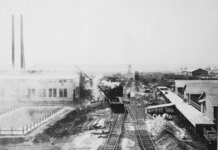
In 1907, the Birmingham Chamber of Commerce commissioned young journalist Ethel Armes to pen the first history of the state’s extractive industries. Drawn from extensive interviews, long-lost sources and written with flare, “The Story of Coal and Iron in Alabama” remains an indispensable account of the state’s business history.
Armes was born in Washington, D.C., in 1876. At 13, she became a regular contributor to the pages of The Washington Post, through its Association of Amateur Writers. After a yearlong stint at the Chicago Chronicle, Armes returned to the Post in 1900 and remained for about three years.
The journalist had Alabama ties through her brother George Armes, a civil engineer who worked throughout the state. She moved to Alabama, perhaps along with her mother, in 1903. Her byline first appeared in the Birmingham Post-Herald in April 1903. She wrote for the paper sporadically as she freelanced for literary and social magazines, including The National, published in Boston.

In 1905, she published her first book, which explored the history of the White Mountains region of New Hampshire. In May 1906, Armes temporarily assumed the duties of the Post-Herald’s society editor. But her interests were more in the economic and social workings of the city than in the happenings of the muckety mucks.
How Armes came to be commissioned by the Chamber of Commerce is not clear. News of the project landed in the summer of 1907, through a series of articles outlining the scope of work. Industrialist Truman H. Aldrich led the charge, as newly installed president of the chamber. A committee supporting the work included insurance executive Louis Clark, banker David Roberts, Birmingham News founding publisher Rufus Rhodes and industrialist Henry F. DeBardeleben. These men undertook the work of securing subscriptions to offset the cost of publication, ultimately raising roughly $2,000.
Meanwhile, letters of support and rafts of primary sources arrived for Armes daily. Committees in Bibb and Talladega counties formed to aid in her work. Thomas McAdory Owen, founding director of the Alabama Department of Archives and History, supplied material. Photographers were dispatched to the ruins of early factories and mill towns to capture illustrations. Armes went on a grand tour of industrial Alabama in an automobile furnished by a chamber member. The work was done quickly and well.
Published in the fall of 1910 by University Press, Cambridge, Massachusetts, and sold for $5 (roughly $170 today), “The Story of Coal and Iron in Alabama” was bound in red vellum cloth with gilded sides. It featured nearly 100 illustrations, many of them made specifically for the book. It was a monumental achievement, as lyrical as it was methodical, for a book nearing 600 pages in length. Copies of the first edition are exceedingly rare. According to one account, most of the unsold original stock was inadvertently discarded.
Armes cast Birmingham and the Yellowhammer State as the emerging “ultimate rival of the Pittsburgh District” that had dominated the iron and steel industry. Alabama was not new to this field, she argued, only new to promoting it. “The iron-masters of the state have all been far too busy making iron ever to think of the making of books about it.”
Thus did Ethel Armes chart her course through Alabama’s long story of coal and iron, stories of blacksmiths entering the Creek nation, through pre-statehood mining efforts in north Alabama, through the small antebellum blast furnaces, to the roiling forges of war and fires of Reconstruction, to the great emergence of Birmingham, and into the American century. Her book ends with the 1907 acquisition of the Tennessee Coal, Iron & Railroad Co. by U.S. Steel, something which showed the “infinite promise of Alabama,” she wrote. Armes predicted progress and achievement for the future “seen in long vista ahead as the modern lights are turned on.”

Critics largely obliged Armes her tinseled conclusion. It was, after all, a publication of the Birmingham Chamber of Commerce. Still, few could deny the intellectual heft of the book. Thomas M. Owen said the exhaustive book was without rival. “No state…not even Pennsylvania, has so complete a record.” Manufacturer’s Record, a leading trade publication of the day, called the book “bold” and “splendid,” worth every penny of its steep price. The Times Herald, a hometown paper for the Washingtonian author, called the book “a distinct addition to historical literature.”
Armes devoted much of her subsequent journalism in Alabama to industrial laborers, the kinds of individuals whose stories did not make the pages of the chamber’s history book. In the months after she returned to regular newspaper work, now with The Birmingham News, Armes was identified as a “sociological reporter.” Here, her Progressive era muckraking was on full display, with articles on smoke pollution, women in the workforce, the prevalence of child labor, socioeconomic conditions of African Americans in Birmingham’s mines and more. Alongside her journalism, Armes took on active roles in the women’s suffrage movement and worked to organize the United Mine Workers in the Alabama coalfields. In 1912, she became one of the first women to receive government certification as a mine rescue worker, complete with headgear and oxygen mask.
Over time, her byline appeared in Alabama with less frequency. Magazine work and other opportunities drew the attention of her untiring pen. By about 1915, her time in Alabama was at an end. Later in her career, Armes wrote feature stories for the Boston Herald and was a staff writer for the Theodore Roosevelt Memorial Association. Armes became a noted preservationist and was among those largely responsible for saving Stratford Hall, the ancestral Virginia home of Robert E. Lee.
When she died in 1945 at the age of 68, Armes was working on a book about the Lee family. Thus, she never truly set down her pen. An author could ask for no more appropriate ending, than to be allowed to write until the end and to have the work remembered.
Historian Scotty E. Kirkland is a freelance contributor to Business Alabama. He lives in Wetumpka.
This article appears in the March 2025 issue of Business Alabama.



